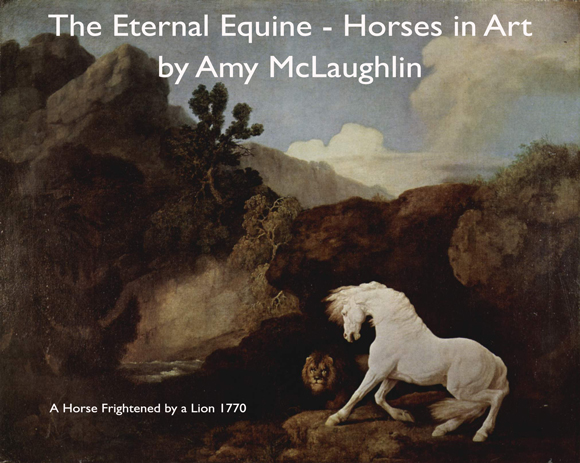The Eternal Equine - Horses in Art
by Amy McLaughlin
Some 30,000 years ago, in the flickering torchlight of a cave, our distant ancestors painted animals, including horses. Using techniques very similar to those of a modern artist -- brushes, cloths, their fingertips, charcoal and pigment made from minerals and plants -- they covered the rough cavern walls with images of tremendous power and immediacy. The horses and other animals in the great bestiaries at Chauvet, discovered in 1994, were executed with a sophistication that overturns notions of linear progress in art. Set beside recent images such as the work of Susan Rothenberg, these prehistoric images leave one with the unanswerable enigma of eternal recurrences. In what ways has the impulse to paint a horse changed, or remained the same? These images look as if they could have been painted yesterday, coming from a sensibility that seems familiar and relatable.
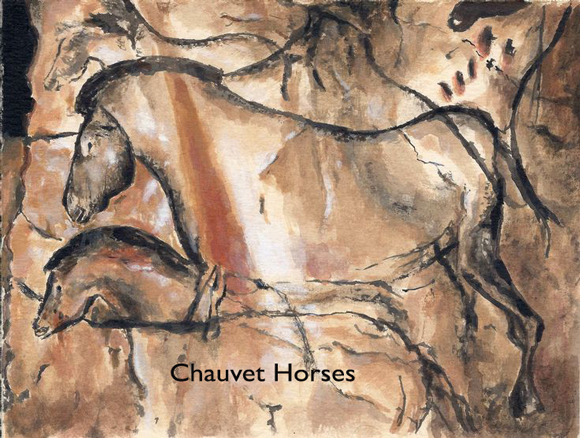
My own guess is that there was some religious element in these paleolithic works, but the particular beliefs these early homo sapiens may have had are a mystery. Various theories have been suggested -- the murals were shamanistic, for use in initiation rites; or they measured out the seasons by depicting groups of animals according to the times of year they bred. No one, of course, knows for sure.
The paintings are in some respects suggestive of a sketchbook, the essential lines set down in a pure and direct response to the subject. How did these artists learn, practice, and prepare? There is little, if any, hesitation in these paintings. The mural showing several horses side by side, their heads close together, is remarkable in the subtle suggestion of modeling of the form and the different psyche of each animal. The draftsmanship is assured and beautiful.
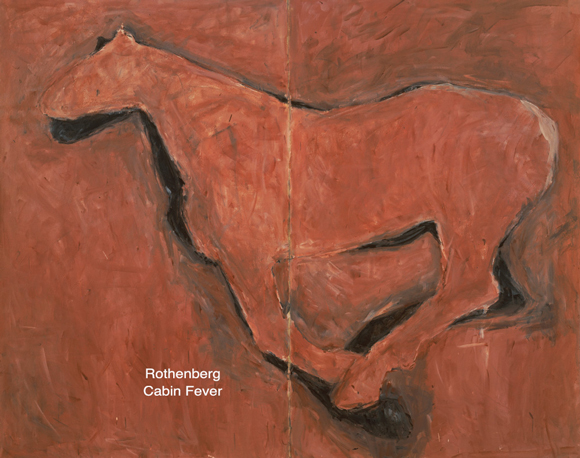
As a subject in art, horses have always been among the most frequent and favored. They are shown in their familiar roles -- lending their strength to humans for warfare, from Amenhotep III driving his chariot and the Assyrian palace at Nineveh, to paintings of the cavalry in the First World War. They are seen pulling ploughs and carts, hauling barges along towpaths, and drawing coaches. The pictures tell the story: civilization was built on their backs. Without them, war, empire building, communication and travel, construction, and agriculture would not have been possible on anything like the scale that was achieved.
In Greek art the horse, along with deer, was the most commonly represented animal. The 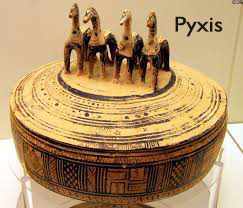 pyxis surmounted with four horses was likely made in Athens around 8 BC. These were used for storing cosmetics or jewelry, much as a similar box might be used today. The owner of the pyxis was surely a member of the emerging aristocracy, as horses were already associated with wealth and privilege. These four horses, a quadriga that drew a chariot - traces of the harness painted on them are still visible - may have referred to the military status of the lady's family.
pyxis surmounted with four horses was likely made in Athens around 8 BC. These were used for storing cosmetics or jewelry, much as a similar box might be used today. The owner of the pyxis was surely a member of the emerging aristocracy, as horses were already associated with wealth and privilege. These four horses, a quadriga that drew a chariot - traces of the harness painted on them are still visible - may have referred to the military status of the lady's family.
About 300 years separate the pyxis from the friezes on the Parthenon. These were executed under the direction of the great Phidias during the 5th century BC, the golden age of Athens, the time of Pericles. The advances in proportion and perspective that  revolutionized Greek architecture made an impact on the visual and decorative arts as well. The artists who sculpted these horses paid attention to anatomy and to the proportions of the overall composition. The elements that have become synonymous with western classicism are balance, harmony, and proportion. All of the figures were originally painted, so the assumption that everything about Greek art, was pure and monochromatic is incorrect, a consequence of time and weather scrubbing the marble clean.
revolutionized Greek architecture made an impact on the visual and decorative arts as well. The artists who sculpted these horses paid attention to anatomy and to the proportions of the overall composition. The elements that have become synonymous with western classicism are balance, harmony, and proportion. All of the figures were originally painted, so the assumption that everything about Greek art, was pure and monochromatic is incorrect, a consequence of time and weather scrubbing the marble clean.
As Christianity took hold in Europe, the horse continued to ennoble and serve humans as knight errants replaced the vanished classical heroes. These were soldiers who served God and subscribed to the chivalric code -- the word chivalry, was taken from 'cheval', meaning horse. Durer's 'The Knight, Death and the Devil' (1513), has to be one of the least romanticized depictions. There is no glamour about this haggard, rather grim knight as he rides past death and the devil, resolutely following his god. A work that belongs to the Renaissance, when a focus on observing nature had returned, Durer knew his equine anatomy as well as the sculptors of the Parthenon did. But here, there is no idealization at all.
Two of the greatest horse painters who ever lived were born in the 18th century and influenced by the Enlightenment and Romanticism, but both artists were outliers by virtue of their chosen subject. At a time when scientific inquiry was exploding, artists with the right temperament and curiosity might devote attention to carefully observed work, with a deeper understanding of anatomy than most of their predecessors had.
George Stubbs, arguably the greatest horse painter who ever lived, was almost entirely self-taught. He did copy some of the paintings that belonged to the Earl of Derby, but that can't explain his brilliant, factitious skill. He studied horses with tireless dedication, spending months dissecting them in preparation for making detailed engravings that showed each level of musculature. His contemporaries said that the outbuildings where he worked gave off a permanent and unbearable reek. The abattoir atmosphere of Stubbs' workshop is a jarring and repellent thought. A person who has at least questioned the way in which we treat animals may wonder if there wasn't some flinching, a transitory flash of cognitive dissonance, when the artist who was so sensitive to the beauty of horses, coolly butchered and cut them apart to study. His fascination with equine anatomy was so strong that even his honeymoon didn't interrupt these activities. The resulting paintings are incredibly beautiful, serene works of art. Every element is breathtaking -- the draftsmanship, the perfectly balanced compositions, and the exquisite, virtuoso handling of the paint. One of his finest works is in the Metropolitan, a bay hunter with a groom. The feeling is one of contentment, with both man and horse looking relaxed. The setting is tranquil in the way that afternoon heat, faintly muggy, can be. This ability to convey the atmosphere itself, the sense of what the air felt like, is another testament to Stubbs' genius. In one of those puzzles of subjective seeing, quite a few of his patrons disliked his landscapes, and insisted that another artist be brought in to complete the works after Stubbs had painted the horse.
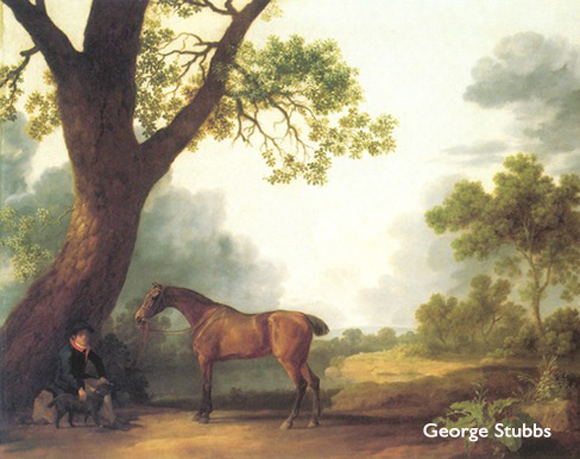
Stubbs and another, earlier genius, Leonardo da Vinci -- who was no slouch at drawing horses himself -- share an almost preternatural sense of beauty combined with a chilly, scientific aloofness. Both artists held the unswerving belief that an artist needed to refer constantly to nature, and understand as thoroughly as possible the inner mechanics of whatever they were painting. Although Stubbs was painting in the early Romantic Age, the beginning of the modern apotheosis of individual expression, a measure of classical calm pervades almost all of his work. The notable exceptions are the paintings of horses attacked by lions, which are a stark contrast to the placid views of rural life.
There is a story about Stubbs watching, while in Morocco, a lion stalk and take down a Barbary horse. It must have been a riveting and horrifying scene to witness, and if the story is true, it explains his famous obsession with the theme. He painted at least 17 versions of a horse attacked by a lion, and these are consummate examples of Romantic Age art -- a heroic struggle between two noble beasts, most often set in an isolated, rocky landscape, with roiling clouds overhead.
However, the majority of Stubbs' paintings celebrate the golden Elysium of pre-Industrial English country life, gentle pastoral scenes with mares and foals, or a favorite riding horse or hunter. He also painted numerous racehorses, including the famous Eclipse. A great-grandson of Godolphin Arabian, Eclipse won all 18 of his starts and his domination on the track gave rise to the expression 'Eclipse first, and the rest nowhere. Stubbs' portraits of Eclipse — there are several -- are typical of his work, authoritative but unpretentious renderings of a handsome chestnut stallion, often painted near the [rubbing down house] at Newmarket. Despite his acknowledged brilliance, Stubbs was relegated (and sometimes still is) to the category of mere sporting artist, and was denied admission to the Royal Academy.
Close to rivaling Stubbs in skill was the Swiss painter Jacques-Laurent Agasse. He was a child prodigy and up to a point, self-taught, but unlike Stubbs, he eventually had the benefit of three years' study with a master, Jacques Louis David, in Paris. He had been drawing horses from childhood and was unimpressed by the aesthetic dogma of the time, which held history paintings to be the highest echelon of art. He learned what he could in David's studio, but remained true to his own affinity for animals and was convinced horses deserved serious attention. While in Paris, he enrolled for a time as a veterinary student and also painted at the Musee d'Histoire Naturelle.
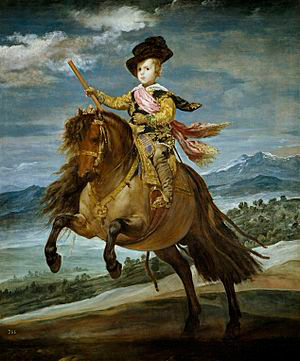 The equestrian portrait was a tool of public relations, used to make powerful people appear even more commanding. Often, the prince or potentate's mount would be rising in a levade, showing the rider's easy mastery over the animal, and not so subtly implying an ability to neatly rule humans, as well. Velasquez painted one such portrait of Prince Baltasar Carlos on his pony. Dressage riders may speculate on how likely it was that the little prince was such an accomplished equestrian, riding the movement easily with one hand and gazing imperiously at the viewer, but it is beside the point -- the image, created by one of the great geniuses of western art, is unforgettable.
The equestrian portrait was a tool of public relations, used to make powerful people appear even more commanding. Often, the prince or potentate's mount would be rising in a levade, showing the rider's easy mastery over the animal, and not so subtly implying an ability to neatly rule humans, as well. Velasquez painted one such portrait of Prince Baltasar Carlos on his pony. Dressage riders may speculate on how likely it was that the little prince was such an accomplished equestrian, riding the movement easily with one hand and gazing imperiously at the viewer, but it is beside the point -- the image, created by one of the great geniuses of western art, is unforgettable.
The apex of rearing horse propaganda, though, has to be Jacques Louis David's portrait of Napoleon crossing the Alps. The horse is modeled with lapidary perfection, the surfaces of its body as smooth and polished as those of the surrounding rocks. The entire painting has the appearance of being a carved monument to the emperor, rather than an even remotely realistic image. Napoleon actually crossed the Great Saint Bernard Pass the same way that Christ entered Jerusalem, on a humble donkey.
Napoleon's instructions to David were to portray him “calm, mounted on a fiery steed.” As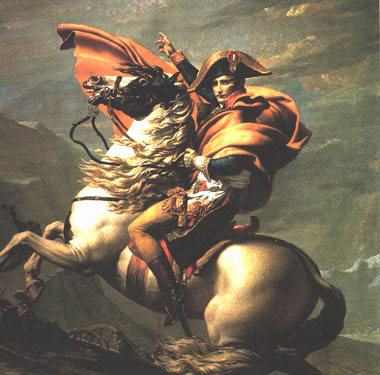 is so often true in the depiction of horses, we seem pleased by seeing a distressed animal, with wild eyes and flaring nostrils, whose agitation becomes the proxy for human drama.
is so often true in the depiction of horses, we seem pleased by seeing a distressed animal, with wild eyes and flaring nostrils, whose agitation becomes the proxy for human drama.
In the millennia since humans arose and began responding to and depicting the world around them, the ambivalent relationship we have with horses, as with the rest of nature, is evident. The magnificent horses of Chauvet were almost certainly hunted for their meat. The rearing, snorting horses ridden by warriors of many different times and places were not happy to be dragged into our battles. One's mind can snag on the human talent for compartmentalizing the inherent beauty of something, and its usefulness to us. The emotions of the artists of the past are almost entirely a matter of conjecture, but the sense of awe about something so beautiful has been present from the very beginning.
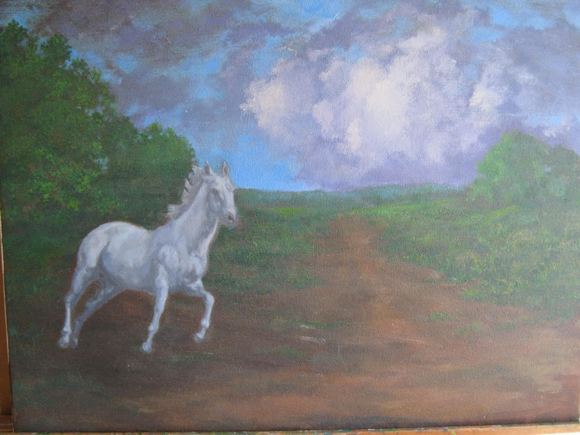
White Horse, Running by Amy McLaughlin
Editor's Note: CH didn't think this article would be complete without including a look at the wonderful artwork of this article's author



